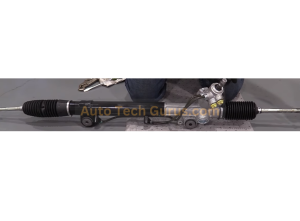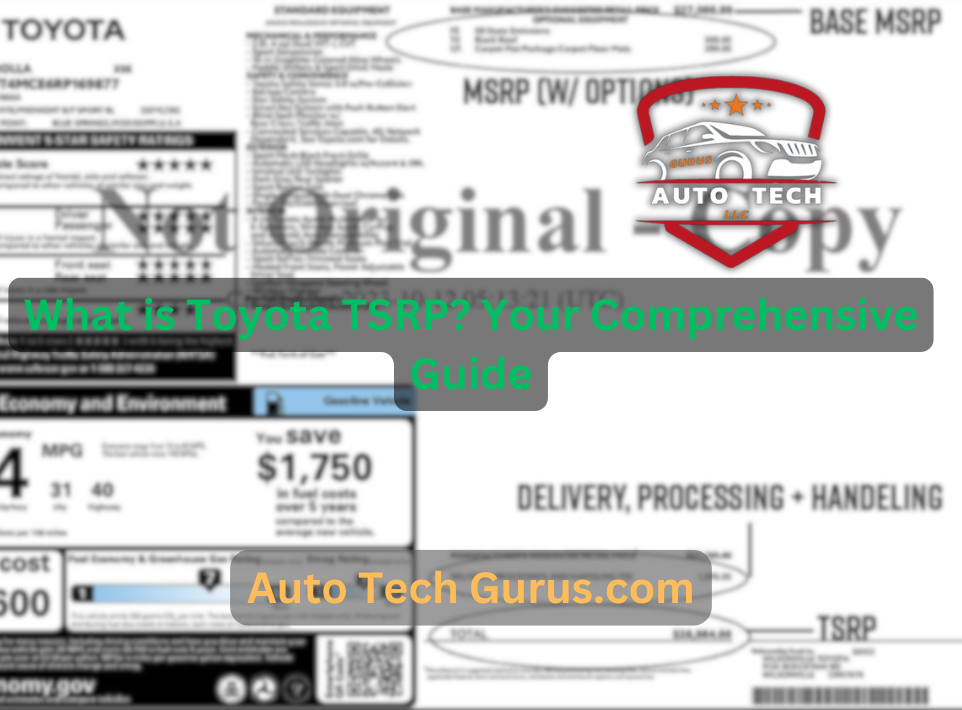Regarding the world of mid-sized trucks, the 99 Toyota Tacoma stands as a paragon of reliability and versatility. Known for its steadfast performance under varying conditions, this model remains a favorite among truck enthusiasts. What makes it more interesting is its steering system’s vital role in augmenting its performance and ensuring smooth rides.
The Importance of Knowing Your Vehicle’s Steering System (Power Rack vs. Manual Rack) for Performance and Maintenance
Understanding the kind of steering system, whether a power rack or a manual rack, is crucial in vehicles. This knowledge not only contributes to an enhanced driving experience but also aids in properly maintaining the vehicle.
The steering system is the heart of your vehicle’s maneuverability, often dictating performance, control, and even fuel efficiency.
Does the 1999 Toyota Tacoma Have Power or Manual Steering?
Now, you might wonder, “Does the 99 Toyota Tacoma come with a power rack or a manual rack?” This question is the heart of our discussion today. The objective of this article is to provide a clear and concise answer to this query, allowing you to better understand your vehicle or perhaps make an informed choice if you’re considering buying a 99 Toyota Tacoma.
So, let’s delve into the details and unravel the mystery of the Toyota Tacoma’s steering system.
Understanding Steering Systems
Steering is a critical part of any vehicle. It allows the driver to control the vehicle’s direction and maneuver it successfully.
primary types of steering systems:
Here, we will discuss two primary steering system types: power and manual. Each system has its own unique characteristics, advantages, and disadvantages.
Power Steering vs. Manual Steering
Power steering is a system that assists in steering the wheels using some power source. It uses an engine-mounted pump to pressurise a two-way ram, which helps push or pull the rack in one direction.
This system can be divided into hydraulic and electronic power steering. Power steering systems are prized for their ease of use and versatility, offering almost the same response and performance as a manual rack without the hassles.
On the other hand, manual steering is a different type of steering where manual force is used. It is simple, reliable, and beloved by enthusiasts. Manual steering is connected to a rod that turns the wheels according to the steering direction, a system known as rack-and-pinion steering.
Advantages and Disadvantages
Variable-rate rack power steering systems are advantageous for power-assisted steering because the higher steering ratio near the center position requires more effort from the driver, making the steering feel heavier and more controlled. They offer a more direct and precise steering response, especially in rack-assist electric power steering systems where the electric motor is integrated into the steering rack assembly.

However, power steering systems are more complex, involving components like a pump, belt, high-pressure, low-pressure, and power steering reservoir. This complexity can lead to more potential points of failure.
Manual steering systems, in contrast, are less complex. The only thing that can fail in a manual steering system is the seals on each end of the rack. They offer a more direct connection to the road, providing a more tactile driving experience. However, manual steering can be physically demanding, especially in larger or heavier vehicles, mainly when the car is stationary or moving at low speeds.
Examining the 99 Toyota Tacoma’s Steering System
Like any vehicle, the 99 Toyota Tacoma relies heavily on its steering system for performance and control. This system is responsible for the vehicle’s maneuverability, making it a critical component to understand and maintain.
The Steering System of the 99 Toyota Tacoma
The 99 Toyota Tacoma is equipped with a power steering system. This system uses an engine-mounted pump to pressurize a two-way ram, which helps push or pull the rack in one direction. The power steering system in the 99 Tacoma is designed to provide ease of use and versatility, offering a more direct and precise steering response. However, it’s important to note that the power steering system in the 99 Tacoma, like any mechanical system, can experience issues. For instance, some owners have reported problems with the steering becoming stiff, often due to the seizing of the Intermediate Steering Shaft, a common issue in many Tacomas
Other issues can include the power steering fluid being sucked into the engine due to a failed vacuum switch, leading to fluid loss.
The Importance of Identifying the Specific Steering System
Identifying the specific steering system in your vehicle is crucial for several reasons:
- It helps you understand how your vehicle operates, which can enhance your driving experience.
- It aids in the proper maintenance of your vehicle, as different steering systems require different care and attention.
- It can help you diagnose and address any issues that may arise, such as stiff steering or fluid loss.
Common Misconceptions and Confusion
There’s often confusion surrounding the steering system of the 99 Toyota Tacoma, primarily due to various issues that can arise. For instance, stiff steering can be mistaken as a sign of a manual rack when, in fact, it’s often due to problems within the power steering system, such as a seizing Intermediate Steering Shaft.
Another common misconception is that issues with the steering system always require a complete steering rack replacement. However, problems can be resolved in many cases by replacing specific components, such as the steering rack bushings.
MUST READ>> How Much Weight Can a Toyota Tacoma Pull? Your Complete Towing Guide
Power Rack or Manual Rack:
Which One Does the 99 Toyota Tacoma Have?
The 99 Toyota Tacoma has been the subject of many discussions, particularly regarding its steering system. Given its reputation for reliability and versatility, understanding its steering system is crucial for existing and prospective owners.
The Definitive Answer
So, what’s the answer to the burning question: is the 99 Toyota Tacoma equipped with a power or manual rack? The 99 Toyota Tacoma comes standard with a power rack and pinion steering system.
This is the definitive answer, supported by factory specifications and official documentation.
Substantiating Evidence
The power steering system of the 99 Toyota Tacoma can be confirmed by looking at official specifications or the product description for a replacement power steering rack and pinion assembly specifically designed for the 99 Tacoma.
Moreover, any reputable auto parts supplier will list the 99 Tacoma’s steering system as a power rack and pinion assembly, further substantiating this.
Variations and Exceptions
While the 99 Toyota Tacoma is standardly equipped with a power steering system, it’s important to note there could be exceptions. For instance, certain modifications or aftermarket alterations might have been made to specific vehicles.
For simplicity and a more direct connection to the road, some owners may convert the power steering system to a manual one. However, these are not factory defaults but instead personal modifications.
Implications and Maintenance Considerations for the 99 Tacoma’s Steering System
Understanding the steering system of your 99 Toyota Tacoma is not only crucial for maintenance but also plays a significant role in the overall driving experience.
Implications of the Power Steering System
With a power rack steering system, the 99 Tacoma offers a smooth and effortless driving experience. This system provides a highly responsive steering feel, which is particularly beneficial during high-speed drives and when maneuvering through tight spaces.
However, it’s worth noting that power steering systems can sometimes feel less ‘connected’ to the road compared to manual racks, which offer a more tactile driving experience.
Maintenance Tips and Recommendations
Maintaining the power steering system of your 99 Tacoma requires regular checks and preventive measures. Here are some tips to ensure your system remains in top condition:
- Check the power steering fluid regularly: The fluid level should be within the recommended range. Low fluid levels can lead to stiff steering and even damage the system.
- Inspect the steering belt: A worn-out belt can affect the functionality of the power steering system. If you notice any cracks or signs of wear, consider replacing the belt.
- Regular servicing: Ensure your vehicle undergoes regular servicing, and any issues with the steering system are addressed promptly.
Known Issues and Solutions
One common issue with the 99 Tacoma’s power steering system is the stiffening of the steering wheel, often due to the seizing of the Intermediate Steering Shaft. In case you experience this, it’s advisable to get the components checked and replaced if necessary.
Another common problem is the power steering fluid being sucked into the engine due to a failed vacuum switch, leading to fluid loss. Regularly checking your power steering fluid levels and replacing the vacuum switch if necessary can prevent this issue.
Like to Read>> Do Toyota Camrys Have Apple CarPlay? A Deep Dive into Integration and Benefits
Frequently Asked Questions (FAQs):
What is a power rack steering system?
A power rack steering system, also known as power-assisted steering, utilizes hydraulic or electric power to assist the driver in turning the wheels.
This system provides more effortless steering effort, especially at low speeds or when maneuvering tight spaces.
What is a manual rack steering system?
A manual rack steering system, or manual steering, does not have power assistance.
The driver relies solely on physical effort to turn the wheels. This system is typically found in older vehicles or those designed for simplicity and fuel efficiency.
How can I identify whether my 99 Toyota Tacoma has a power or manual rack?
The most reliable way to determine the type of steering system in your 99 Toyota Tacoma is to refer to the vehicle’s documentation, such as the owner’s manual or specifications provided by the manufacturer.
These sources indicate whether it has a power rack or manual steering system.
Are power rack steering systems more desirable than manual rack systems?
The preference between power and manual rack steering systems largely depends on personal driving preferences and needs. Power rack systems offer more effortless steering effort, especially in parking or low-speed situations.
In contrast, manual rack systems may provide a more direct and engaging steering feel. Consider your driving style and priorities to determine which system is more suitable for you.
Can I convert my manual rack steering system to a power rack system?
Converting a steering system from a manual rack to a power rack or vice versa is possible but often requires significant modifications and expertise.
It is recommended to consult with a professional mechanic or automotive specialist to assess the feasibility and potential implications of such a conversion.
Are there any common issues or maintenance considerations specific to the steering system in the 99 Toyota Tacoma?
While the 99 Toyota Tacoma is generally known for its reliability, regular maintenance on the steering system is important. This includes checking for fluid leaks, ensuring proper alignment, and promptly addressing any unusual noises or stiffness.
Refer to the vehicle’s maintenance schedule and consult a qualified technician for specific recommendations.
Conclusion
In this article, we delved into the steering system of the 99 Toyota Tacoma, answering the central question: it is equipped with a power rack and pinion steering system.
We discussed the implications of having a power steering system, which includes a smooth and effortless driving experience but can sometimes feel less ‘connected’ to the road than manual racks.
We also provided maintenance tips, such as regularly checking the steering fluid and inspecting the steering belt, to ensure optimal performance.
Moreover, we discussed common issues associated with Tacoma’s power steering system, including stiffening of the steering and fluid loss due to a failed vacuum switch, and offered potential solutions to these problems.
Please share your experiences or ask further questions in the comments section. Your insights can be valuable to other Toyota Tacoma owners and enthusiasts.



